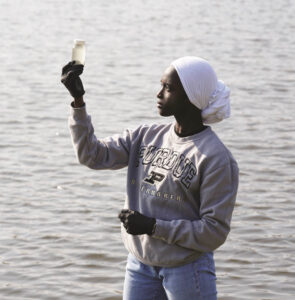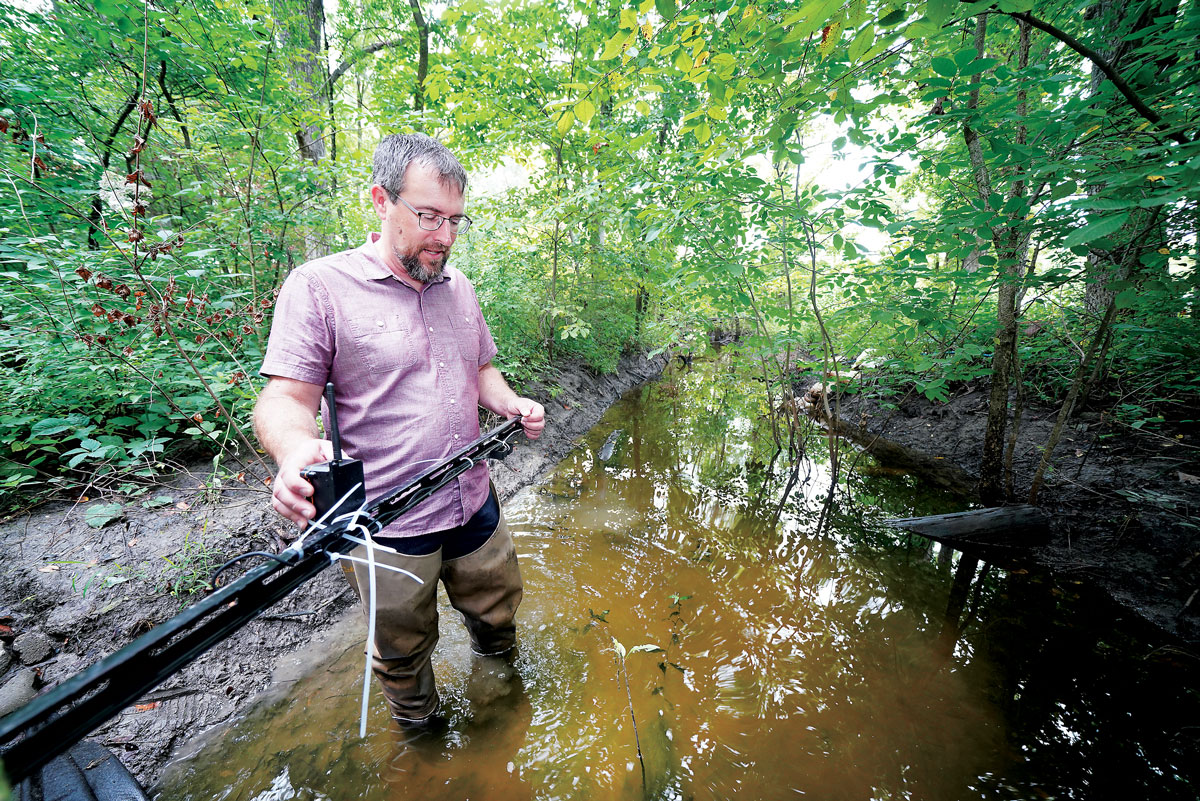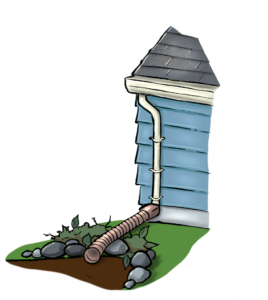A World
WHERE THE
Water Flows
BY EMILY MATCHAR
A World
WHERE THE
Water Flows
BY EMILY MATCHAR
An aerial view of the Wabash River in Indiana.
Our daily interactions with water are so commonplace we probably give them little thought. We expect it to flow out of the tap — or might wonder if we need an umbrella for the day.
For many researchers at Purdue, however, thinking about water is a full-time job. They know that having a clean, abundant water supply is not a given. They are dedicated to ensuring that our waterways are healthy and our drinking water is safe. Ask them “How’s the water?” and they’ll tell you about concerns the average person may be completely unaware of. Yet they are, by and large, optimistic about the power of education, technology and community to secure this fundamental natural resource.
GETTING WATER WHERE WE NEED IT, WHEN WE NEED IT

“I get annoyed at headlines that claim we’re running out of water,” says Laura Bowling, professor of agronomy and director of the Natural Resources and Environmental Science program. “Globally we’re not running out of water, but we don’t have it where and when we need it.”
In Indiana, the “where and when we need it” problem looks like increasingly wetter winters and springs, and hotter summers. Farmers have too much water during the planting season and must figure out ways to drain the excess. Then they’re left with dry fields during the blazing summer months. One solution is better water storage: Reserve spring rainwater to use in the summer using storage ponds, storage ditches or controlled drainage systems. Each system has strengths and drawbacks. Ponds capture the most water but cost a lot and require land. Controlled drainage is cheaper but requires investment and time to manage, which scares off some farmers.
Bowling has a prototype drainage water recycling system at Purdue’s Agronomy Center for Research and Education. She and her team have taken a wetland in a corner of the farm too wet for crop production, and use it to store water drained from the corn and soybean fields. That water can later be used to irrigate the same fields it was drained from. “It’s really low tech,” Bowling says. “Hydrology for the most part is low tech.”
Jane Frankenberger, professor of agricultural and biological engineering, is similarly interested in understanding how drainage systems can be improved and adapted to changing climate conditions.
“The biggest impact of climate change on Hoosiers is increases in flooding,” she says. “We’re expecting that to continue, and more people are going to suffer, so that makes our work more urgent.”
Frankenberger directed Transforming Drainage, an eight-state project with experts from a variety of disciplines, including agricultural engineering, soil science, agronomy and economics. The six-year project looked at the economic and environmental costs and benefits of storing drainage water. The team studied practices like controlled drainage and drainage water recycling, and developed materials to educate farmers and other stakeholders about such systems.
One major benefit of keeping water stored in the field is that nutrients like nitrogen can be put back into the earth, rather than running off into streams, where the nutrients eventually cause problems like algal blooms and oxygen deficiency.
“The major water quality issues are now dissolved pollutants,” Frankenberger says. “People think that they can see pollutants, and if the water is clear, it’s not polluted. That’s just not true. Clear water is what’s causing algae in the Gulf of Mexico and Lake Erie.”

Sokhna Sall (BS ’22, agricultural and biological engineering), who majored in environmental and natural resources engineering, samples water in West Lafayette’s Celery Bog Nature Area.
“I get annoyed at headlines that claim we’re running out of water,” says Laura Bowling, professor of agronomy and director of the Natural Resources and Environmental Science program. “Globally we’re not running out of water, but we don’t have it where and when we need it.”
In Indiana, the “where and when we need it” problem looks like increasingly wetter winters and springs, and hotter summers. Farmers have too much water during the planting season and must figure out ways to drain the excess. Then they’re left with dry fields during the blazing summer months. One solution is better water storage: Reserve spring rainwater to use in the summer using storage ponds, storage ditches or controlled drainage systems. Each system has strengths and drawbacks. Ponds capture the most water but cost a lot and require land. Controlled drainage is cheaper but requires investment and time to manage, which scares off some farmers.
Bowling has a prototype drainage water recycling system at Purdue’s Agronomy Center for Research and Education. She and her team have taken a wetland in a corner of the farm too wet for crop production, and use it to store water drained from the corn and soybean fields. That water can later be used to irrigate the same fields it was drained from. “It’s really low tech,” Bowling says. “Hydrology for the most part is low tech.”
Jane Frankenberger, professor of agricultural and biological engineering, is similarly interested in understanding how drainage systems can be improved and adapted to changing climate conditions.
“The biggest impact of climate change on Hoosiers is increases in flooding,” she says. “We’re expecting that to continue, and more people are going to suffer, so that makes our work more urgent.”
Frankenberger directed Transforming Drainage, an eight-state project with experts from a variety of disciplines, including agricultural engineering, soil science, agronomy and economics. The six-year project looked at the economic and environmental costs and benefits of storing drainage water. The team studied practices like controlled drainage and drainage water recycling, and developed materials to educate farmers and other stakeholders about such systems.
One major benefit of keeping water stored in the field is that nutrients like nitrogen can be put back into the earth, rather than running off into streams, where the nutrients eventually cause problems like algal blooms and oxygen deficiency.
“The major water quality issues are now dissolved pollutants,” Frankenberger says. “People think that they can see pollutants, and if the water is clear, it’s not polluted. That’s just not true. Clear water is what’s causing algae in the Gulf of Mexico and Lake Erie.”
INVISIBLE PERILS
One concern that’s made headlines in recent years is the presence of per- and polyfluoroalkyl substances (PFAS) — so-called “forever chemicals” — in the water supply. These chemicals, which are widely used in everything from manufacturing to firefighting to cosmetics, don’t break down in the environment and tend to accumulate in the human body. They’re potentially connected to a range of health effects, including altered metabolism, reduced fertility, diminished immune system and an increase in certain cancers.
Linda Lee, distinguished professor of agronomy and environmental and ecological engineering, head of the Ecological Sciences and Engineering interdisciplinary graduate program, and assistant dean in the Office of Agricultural Research and Graduate Education, had PFAS on her mind long before the headlines. She noticed the presence of PFAS in seafood in native Alaskan villages over two decades ago, and has been studying them in earnest since 2005. She’s developed methods for measuring and remediating PFAS and has studied the chemicals’ effects on amphibians and other animals as part of a team led by Professors Maria Sepúlveda and Jason Hoverman in Forestry and Natural Resources.
“It would be hard for you to collect a rainwater sample that didn’t have PFAS in it,” Lee says. “Once they’re in the environment, it’s very difficult to get them out.”
The key is keeping them from entering the environment in the first place. Both corporations and consumers are increasingly aware of PFAS, and it’s now common to see companies declaring their products to be PFAS-free, Lee says.
The Environmental Protection Agency recently proposed regulations to limit the presence of six PFAS chemicals in drinking water. The urgent need for PFAS research has made it a strategic initiative of the Purdue Institute for a Sustainable Future’s Environmental Stressors research community, which includes Lee and Sepúlveda and is co-led by Hoverman.
Another type of invisible contamination is bacterial. Caitlin Proctor, assistant professor of agricultural and biological engineering and environmental and ecological engineering, studies how bacteria can infiltrate indoor water systems.
“Certain microbes can cause disease in humans, and they can’t be completely controlled by our traditional methods like disinfection,” she says.
Take, for example, Legionella pneumophila, the bacteria that causes Legionnaire’s disease, a type of pneumonia. Its greatest impact is on older and immunocompromised people, so it’s a major concern in hospitals and residential care facilities. Disinfection practices at water treatment plants mostly kill off these bacteria, but they can regrow in water systems where water is allowed to stagnate at warm temperatures. Proctor and her team are looking at how probiotics — beneficial bacteria — might help combat Legionella. “It’s using good bacteria to fight bad, in a way,” she says.
When it comes to bacterial contamination, rural water systems have their own challenges, Proctor says. Flooding, increasingly common in many states due to climate change, can introduce pathogens like E. coli into well water. Proctor and her team have launched a grant-funded citizen science study to look at rural water quality. They’re recruiting people with well water systems to take their own water samples and answer survey questions.
“We’re going to communicate with our volunteers about what we find,” Proctor says. “We’re hoping to gain insights about the whole microbiome; not every microbe is a pathogen.”
PREDICTING THE FUTURE
Keith Cherkauer, professor of agricultural and biological engineering and director of the Indiana Water Resources Research Center, uses a variety of high-tech tools, including aircraft- and satellite-based remote sensors, to monitor water levels. By looking at water levels in different locations, Cherkauer can model what local conditions might look like during the next drought or flood.
“If I sat around waiting for another drought, it might be a long time,” Cherkauer says. “But if we look across Indiana or the Midwest, there are localized areas of extreme wetness or dryness each year. We can look at some of those impacts, and then use what we learn to better represent those impacts in models of conditions 25 or 50 or 100 years from now.”

Knowing what Indiana's future weather will look like can help researchers understand how to develop better irrigation systems and water-use recommendations. “There are a lot of people at Purdue and across the state interested in these issues,” Cherkauer says.
Margaret Gitau, professor of agricultural and biological engineering, uses data to help create predictions for the future. While she’s worked in many parts of the world, much of her recent research has taken place in environments where data is scarce or inaccessible. A large project in East Africa attempted to find ways of gathering and using data from remote monitors and to understand policy-related bottlenecks by mining data from existing documents, such as legislation or non-governmental organization publications.
Without this data, it’s difficult to create policy that can guide countries through imminent or inevitable changes like urbanization and climate change with their water resources intact, Gitau says.
“We know what is coming,” she says. “How is an area going to respond? These decisions need to be guided by something, and that something needs to be data.”
Another key step toward developing good policy involves educating stakeholders. Gitau and her team work on how to translate research results into information nonexperts can use.
“We’ve had really good success at bringing indifferent stakeholders, from water resource managers all the way to policymakers,” she says. “We’ve brought all these groups of people together and had success in them talking to each other, understanding each other’s perspectives and also understanding what challenges there are.”
THE POWER OF SMART REGULATIONS
For water research to truly impact individuals, it needs to influence policy. Several Purdue researchers mentioned upcoming development projects in Indiana as evidence of the need for water regulation. One is a current proposal to pump water from the Wabash River Aquifer in Tippecanoe County to power the proposed LEAP Lebanon Innovation District, a technology and manufacturing park in Lebanon, Indiana, which doesn’t have a plentiful aquifer of its own. The Wabash could likely sustain this particular project, experts say. But they’re concerned that Indiana has no laws regulating the transfer of water between communities.
“Today it’s LEAP Lebanon but tomorrow LEAP Crawfordsville could announce they’re doing the same thing,” says Cherkauer. “Terre Haute could say ‘we’re doing it too.’ Technically, Champaign-Urbana (Illinois) could do the same thing, because there’s no Indiana law that says you can’t.”
Water safety and security at home
While individuals can only do so much to impact water quality, there are steps you can take at home.
When it comes to PFAS, shop carefully, looking for products that advertise themselves as PFAS-free, says Linda Lee. “I tell consumers they have control at the cash register,” she says. “If it’s waterproof, if it’s stain-resistant, you can almost guarantee it has PFAS.”
Caitlin Proctor says keeping your home water heater hot enough can help prevent bacterial growth. “I appreciate energy savings and wanting to keep water heater temperature low, but for safety the best is to keep it at 60 Celsius [140 Fahrenheit],” she says.
Proctor also says that stagnant water in pipes can be a concern, so flushing little-used taps before showering can be helpful.
Jane Frankenberger says smarter gardening techniques can help prevent contaminants from reaching the water supply. “On your own yard, you want the water to infiltrate, not run off quickly,” she says. One solution is to plant a rain garden, a small garden of native plants in a shallow depression, to help collect and absorb runoff.
 But the most important thing, Frankenberger says, is to get involved in your community. “You can’t make enough difference on your property alone,” she says. “We have to make a difference together.”
But the most important thing, Frankenberger says, is to get involved in your community. “You can’t make enough difference on your property alone,” she says. “We have to make a difference together.”
A flexible downspout extension has been added to the drainage system so that a rain garden can absorb runoff.
Unchecked withdrawals could eventually hurt local water supplies, Cherkauer says. He and the other experts aren’t against water transfers. But they do want to make sure such transfers happen in a smart, sustainable way.
“How do we leverage our abundant water resources in a way that’s sustainable for agriculture and industry and the people of Indiana?” he says. “I’m an optimist — I think we can do it — but I do think we need to have those conversations.”
In an effort to get experts and community members talking, Frankenberger, who’s also a member of the Purdue ISF Water Challenges research community, worked with the White River Alliance to organize a virtual forum in April to discuss the issue.
Presenters included Frankenberger, Cherkauer (who co-leads the ISF Water Challenges community), staff from the Indiana Department of Natural Resources and the Indiana Geological and Water Survey, staff from the Indiana Department of Natural Resources and the Indiana Geological and Water Survey, and Indiana State Representative Mike Aylesworth, who introduced a bill to require permits for the withdrawal of groundwater over a specific threshold. Cherkauer points to the Great Plains’ Ogallala Aquifer as an example of a resource whose depletion is having wide-ranging consequences.
Due to overuse in agricultural irrigation, the once-plentiful aquifer has been vastly diminished, causing groundwater levels to drop so low that many farmers have had to abandon their wells. Once drained, the aquifer will take thousands of years to replenish.
COMMUNITY INVOLVEMENT IS KEY
Everyone wants water to be plentiful and clean, but most people have no idea what they can do. Purdue Agriculture researchers work with members of the community, from lawmakers to citizen volunteers, to improve water use decisions.
For the past 18 years, Frankenberger has directed the Indiana Watershed Leadership Academy, an annual five-month program for community members across the state. Participants complete a series of online lessons, in-person classes, and personal projects aimed at helping them understand the fundamentals of watershed management so they can make an impact in their own communities. Participants include local government employees, soil and water conservation workers, and retirees looking for volunteer opportunities. With an average of 30 participants per year, the program has graduated 500 people. They’ve gone on to fight for better conservation practices in their local lakes and rivers.
“I get to see local people who are committed to making a difference in their own watersheds, and working with people who are doing what they can to make a difference locally is certainly inspiring,” Frankenberger says.
She and the other Purdue researchers say they feel positive about the future. More people are coming to realize that clean, abundant water takes hard work, and they’re willing to put in the time.
“The younger generations make me feel really optimistic,” Gitau says. “They seem very interested in taking positive action to protect these resources.”
Bowling agrees. “We do have increased awareness,” she says. “We’ve got people who are working on a solution, and I do think we can do better than we have in the past.”

- Purdue Agriculture researchers are working to keep our waterways healthy and drinking water safe through education, technology and community engagement.
- Climate change is causing wetter winters and springs and hotter summers in Indiana, creating challenges in accessing water where and when we need it.
- Researchers are exploring the best ways to store and recycle drainage water, which also helps avoid nutrient runoff in streams.
- Others are measuring and monitoring the presence of PFAS (“forever chemicals”) and bacterial contamination in our water supply.
- Researchers use remote-sensing tools to monitor water levels in areas of extreme wetness or dryness to help predict and model weather and water supply conditions in the future. This information contributes to better irrigation and water-use recommendations.
- In areas where environmental data is scarce, gathering historical information can provide insight. Involving stakeholders for expertise and advocacy is key to the success of any water policy.
- Purdue Agriculture researchers organized a virtual forum, including Indiana environmental agencies and a state representative, to discuss the LEAP Lebanon Innovation District, its water requirements and the need to develop legislation that safeguards the long-term water supply.

